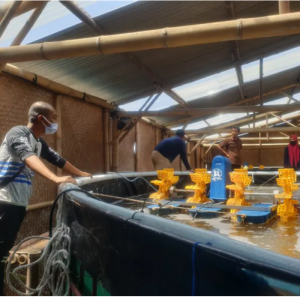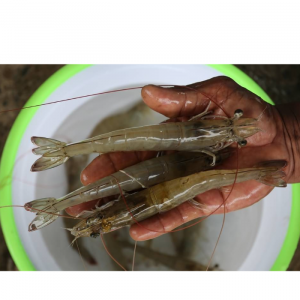
In Short, Synbiotics Are Probiotics and Prebiotics?
| Thu, 03 Jun 2021 - 09:24
Probiotics and prebiotics are considered to be useful and promising alternatives to reduce disease outbreaks in vannamei shrimp. More effective is their combination called Synbiotics.
Probiotics, Prebiotics và Synbiotics
Probiotics are beneficial microorganisms that will penetrate and regulate the composition of the intestinal microflora, maintain intestinal health, increase immunity and promote nutrient absorption of shrimp.
Prebiotics are organic substances that are not digestible but can selectively promote the metabolism and proliferation of beneficial bacteria in the body, thereby improving the health of the host.
Synbiotics, a combination of probiotics and prebiotics, has been used in aquafeeds since 2005 and has been shown to have better growth promoting effects in aquatic animals. Probiotics help to compete with harmful bacteria for living space, and also produce lysozymes during growth, thereby eliminating harmful bacteria.
On the other hand, prebiotics can modulate the adhesion of probiotics, resist the adhesion of opportunistic pathogens, thereby improving the intestinal microbial community of shrimp.
Also read: Research Backs Value of Probiotics in Shrimp Ponds
Research on the Synbiotics Diet
The combined diet of galactose (0.4%) and Lactobacillus plantarum (10 8 CFU/kg) increased the weight of white shrimp by 30.2% while the addition of galactose only increased the weight to 11.7. % and the addition of L.plantarum did not improve shrimp weight.
Synbiotics used in this study included: Bacillus subtilis , yeast, β-glucan, mannan oligosaccharide.
Some probiotics will be inactivated by high temperature and pressure during pelletizing. Therefore, this study compares three complementary methods with the respective treatments:
- Direct addition to the diet before pelleting (DAP)
- Spray after pelletizing (SDA)
- Spray on feed before daily feeding (SDE)
- The control group (CON).
- shrimp intestines
Also read: Can Probiotics Make Shrimp Farming More Environmentally Friendly?

Study on Synbiotics diet on white shrimp. Photo: Tepbac
The effectiveness of the Synbiotics diet
In the study, compared with the control group intake of synbiotics a combination of probiotics and prebiotics. The gut microbiota plays an important role in the regulation of host health, nutrient absorption and immunity.
The symbiotic metabolism of the gut microbiota produces a large number of compounds that can be utilized by the host such as essential amino acids and vitamins. For example, Bacillus Subtilis can synthesize vitamins in the process of metabolism, promoting the absorption of calcium and phosphorus. In addition, enzymes secreted by B.subtilis can break down carbohydrates, lipids and proteins.
Studies have shown that supplementation with mannan oligosaccharides and probiotic preparations ( B.subtilis)) significantly enhanced the intestinal villi length of white shrimp. In this trial, white stool syndrome was observed in the control group at the end of the experiment, while the three groups supplemented with synbiotics showed less white stool syndrome with a smaller, late duration. more and to a lesser extent.
In general, shrimp with white feces syndrome can be observed pathological changes in the intestine and hepatopancreas such as necrosis of the hepatopancreatic ducts that were observed in this study. When synbiotics were added, the morphology of the intestine and hepatopancreas was significantly improved.
The above results indicated that synbiotics supplementation improved the gastrointestinal tract, the morphology of the hepatopancreas and intestines, inhibited the reproduction of harmful bacteria and reduced the occurrence of intestinal diseases.
The hepatopancreas is the main site of digestion and absorption of shrimp. Digestive enzymes in the stomach and intestines are mainly produced by B cells, secreted and transported to the respective digestive organs through the lumen.
In white shrimp, the activity of digestive enzymes in the hepatopancreas was improved by the addition of probiotics in the diet. In this trial, synbiotics also increased the activity of protease and amylase enzymes, which is an important rationale for improved growth and nutrient utilization. Improved digestive enzyme activity may be the result of promoting enzyme secretion and beneficial microorganisms.
Also read: Using a Probiotic Mixture is More Effective Alone

Shrimp's hepatopancreas is susceptible to disease, synbiotics can improve hepatopancreas function. Photo: Tepbac.
SOD (enzyme superoxide dismutase), CAT (enzyme catalase), MDA (organic compound malondialdehyde) are indicators to assess the oxidative stress status of aquatic organisms. In this study, serum SOD and CAT activities were enhanced and serum MDA levels decreased when synbiotics were supplemented, which was due to the positive effects of both probiotics and prebiotics.
Serum ACP (acid Phosphatase), ALP (Alkaline phosphatase) and LYS (Lytic enzyme) activities are important parameters in shrimp nonspecific immunity. When adding Synbiotics, the activities of ACP, ALP and LYS in the synbiotics supplemented group were significantly higher than in the control group. Ingredients in probiotics, such as peptidoglycan, lipoteichoic acid, glucan, and mannose oligosaccharides, can activate the immune system or stimulate the host immune system to produce cytokines.
In other studies on white shrimp, including the present results, the addition of probiotics or prebiotics to the feed also reduced mortality after the trial with Vibrio . Components such as β-glucan and mannan oligosaccharides from probiotics can form complexes with recognition proteins and subsequently activate the expression of immune-related genes and improve immunity.
Also read: Probiotics in Aquaculture
In addition, Bacillus subtilis can produce polymyxins, nystatins and short peptides during growth, which inhibit pathogenic bacteria or endogenous opportunistic infections.
The addition of synbiotics significantly improved the growth performance, nutrient utilization and biological immunity of white shrimp. Furthermore, the daily pre-feeding of synbiotics resulted in more positive results in most parameters than the direct addition of synbiotics to the diet before pelleting.
The reason is that the high temperature (95-100 o C) has inactivated most of the biological products in the pelletizing process. The amount of Bacillus subtilis and yeast cells in the diet directly supplemented with synbiotics was only 5.3*10 4 and 4.7*10 3 CFU/kg, accounting for 0.2% and 0.02% of the diet, respectively. sprayed with synbiotics before feeding (2.5*10 7 -2.8*10 8 ).
Therefore, the improvement in growth performance and immune function mainly came from prebiotics rather than probiotics in the synbiotics direct-supplemented group and from both prebiotics and probiotics in the pre-feeding synbiotics spray group. Therefore, a diet that sprayed synbiotics on the feed prior to daily feeding produced better performance than a regimen that added synbiotics directly to the diet prior to pelleting.
Source: Tepbac.com






















